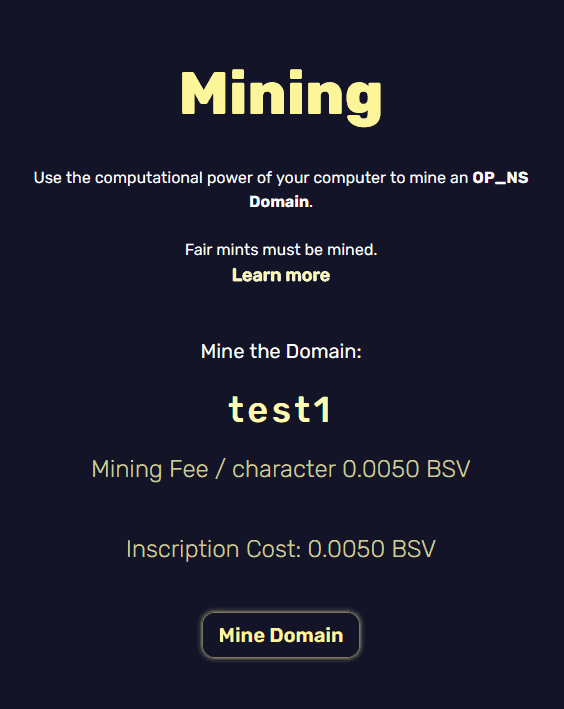|
Getting your Trinity Audio player ready...
|
1Sat Ordinals marketplace and wallet Aym has released the OP_NS protocol and miner of provably unique domain names on the BSV blockchain. Leveraging the Sats Names and BRC-20 protocols of defining namespaces and tokens, OP_NS enforces unique namespaces directly in Bitcoin Script via a stateful contract implemented via sCrypt.
What they don't want you to know about having fun on Bitcoin:
1. mine some OP domains
2. tell your grandma about OP
3. calmly watch as others scramble to mine OP domains@op_enheimer pic.twitter.com/zNs1Hx59BR— Aym 🟡 Aym (@AymRadiant) August 23, 2023
Unlike the text-based protocols on BTC, where indexers and marketplaces must validate the authenticity via the “first is first” principle, names mined via OP_NS cannot be duplicated. “First is first” still applies in the sense that the first to mine the unique name, for example, mining “shua” claims the namespace in the form of a 1Sat Ordinal. To claim, the user must submit the combination of characters they want to mine, along with a hash that proves they did enough proof of work to claim the name. Users claim one character at a time, meaning to mine “shua,” “s,” “sh,” and “shu” must be first mined. If someone else previously mined those character combinations, but a user just wants the unique combination “shua,” they can directly mine “shua.”
The contract that enforces uniqueness is stateful, so its functionality is Ethereum-like, where state is preserved on-chain, however, race conditions can occur. If two users are mining two different names, the first to find the solution via proof of work will spend the contract UTXO, and the second will have to spend from the next state, meaning they may have to stop and redo the proof of work. This is a trade-off of Bitcoin’s scalable UTXO model vs. Ethereum’s global state (which has not proven scalability).
Users can mine in their web browser and, upon success, can immediately list the names for sale on the global order book or send to another wallet.

Aym charges 500,000 satoshis for each character successfully mined, and another 500,000 for inscribing the ordinal NFT. Users are only charged if the mining is successful. The fees are quite high, given that the code runs on the client side and the inscription costs are only a few satoshis. However, since Aym is the first to market, they can charge such fees.
The mining software is open-sourced in TypeScript, so any developer can mine from the terminal, bypassing the platform fees. Additionally, the miner can be optimized or even implemented for GPUs and ASICs since the algorithm is based on SHA-256. If this namespace protocol gains adoption, incentives exist to iterate on this infrastructure, making it more robust and promoting competition.
A drawback is the difficulty of mining is initially arbitrary; low enough so that anyone can mine with their CPU in a web browser. This difficulty is not dynamic, meaning if a developer built a significantly more powerful miner, they could claim all the names easily. Bitcoin solved this with its novel difficulty adjustment algorithm (DAA). Ideally, OP_NS would have implemented this from the start, but that would have been quite cumbersome to do directly in Bitcoin Script.
OP_NS domains are verified name spaces atop Bitcoin, so other protocols could leverage these for other functionality, such as fungible tokens, or collections. The owner of the “aym” domain could issue an “aym” token that is proven to be issued and owned by that namespace. These protocols can also be combined with Proof of Work to have mineable tokens and collections. The possibilities when combining these open protocols are endless—mine your domain today at aym.world/op.
Watch: 1Sat Ordinals on Bitcoin

 12-25-2025
12-25-2025 




